Nation Sites
The Nation Network
CanucksArmy has no direct affiliation to the Vancouver Canucks, Canucks Sports & Entertainment, NHL, or NHLPA
DeBrusk vs. Boeser: Who’s the Canucks’ net-front presence on the power play in 2024/25?
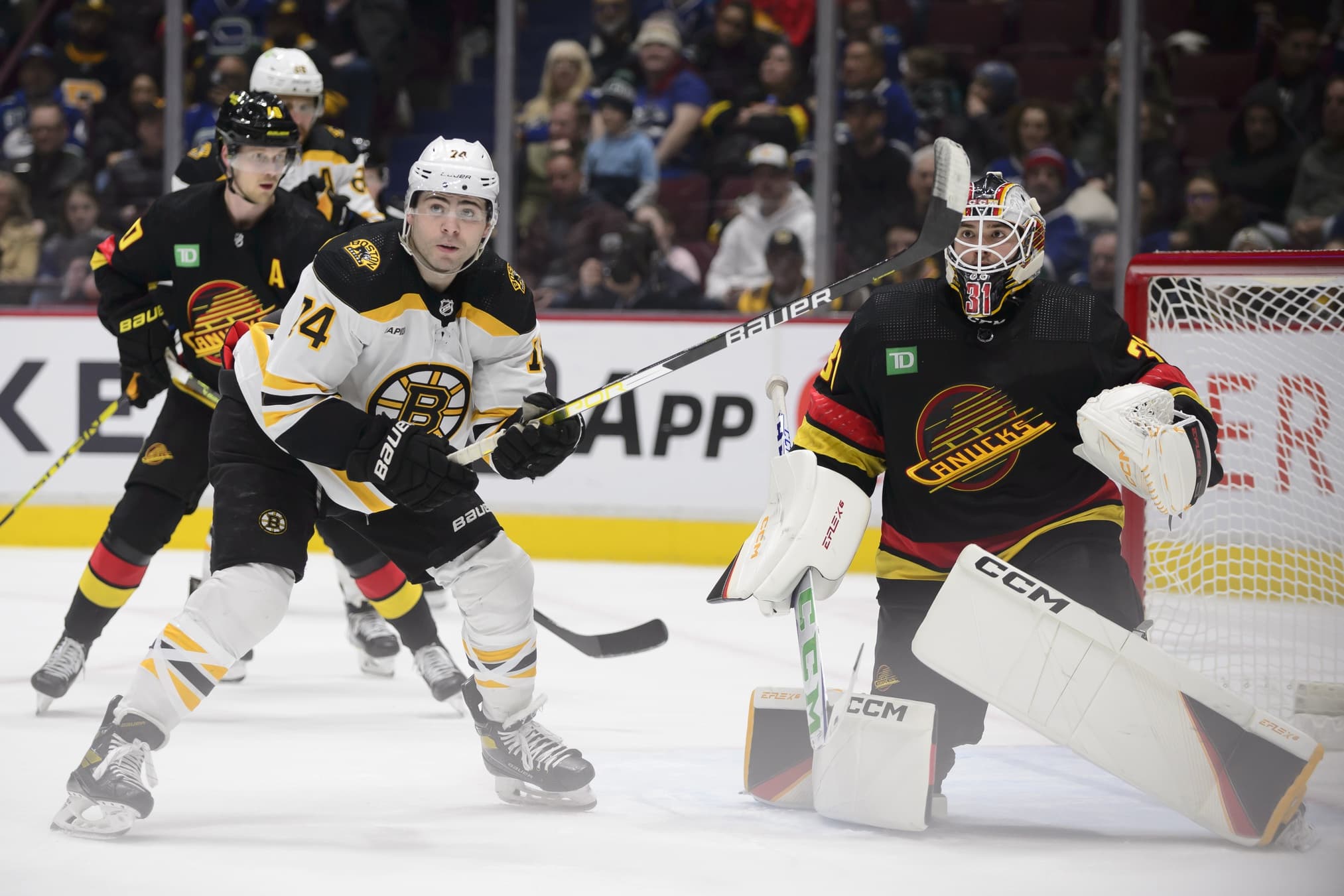
Photo credit: © Anne-Marie Sorvin-USA TODAY Sports
Aug 16, 2024, 14:21 EDTUpdated: Aug 16, 2024, 14:20 EDT
If the Vancouver Canucks could pick just one aspect of their play from the 2023/24 season to improve upon before the 2024/25 season began, it would probably be the penalty kill, which ranked just 17th in the league at a 79.1% success rate.
But if they could pick two aspects, the second would probably be the other half of their special teams, also known as the power play.
The Canucks’ PP wasn’t outright terrible in 2023/24. The team finished with a success rate of 22.7%, good for 11th place in the league.
But that number is a bit of a mirage. The power play was red-hot to open the year, and then started to fade as the season wore on. From the All-Star Break onward, the Canucks scored PP goals at a rate of just 18.8%, down to 24th in the NHL over that stretch. And in the playoffs, they were somehow even worse, checking in at just a 13.9% success rate and 12th place among the 16 postseason teams.
The power play must improve.
Part of that comes through a change in personnel. The Canucks added several new forwards to the mix this offseason, and at least one of them is virtually guaranteed a prominent power play spot in Jake DeBrusk.
He joins Quinn Hughes, Elias Pettersson, JT Miller, and Brock Boeser on what is assumed to be the default PP1 unit.
But new players bring with them new challenges, and one of those challenges that will immediately be raised by DeBrusk’s presence is the question of who now serves the role of net-front presence on the PP.
Against most expectations, Boeser became that player in 2023/24, and performed shockingly well in the role. Whether at 5-on-5 or with the man advantage, some of Boeser’s biggest goals last year – including a number of his heroic playoff markers – came as a result of his quick and clever stick operating in the toughest area of the ice.
https://x.com/CanucksArmy/status/1751474685714595950
https://x.com/CanucksArmy/status/1784735435668988244
Boeser’s heads-up vision, his deft tipping hands, and his strength on his skates are all assets in this regard. He’ll never be considered a physical player, but at 6’1” and 208lbs, he’s at least big enough to stand his ground in the slot.
If needed, this absolutely seems like a role that Boeser can continue to fill. But here’s the thing: it’s also very much a big part of what DeBrusk brings to the table.
Shot charts are a good way to visually demonstrate the stark similarities between these two players. Here’s where they shot and/or tipped from at 5-on-5 in 2023/24:
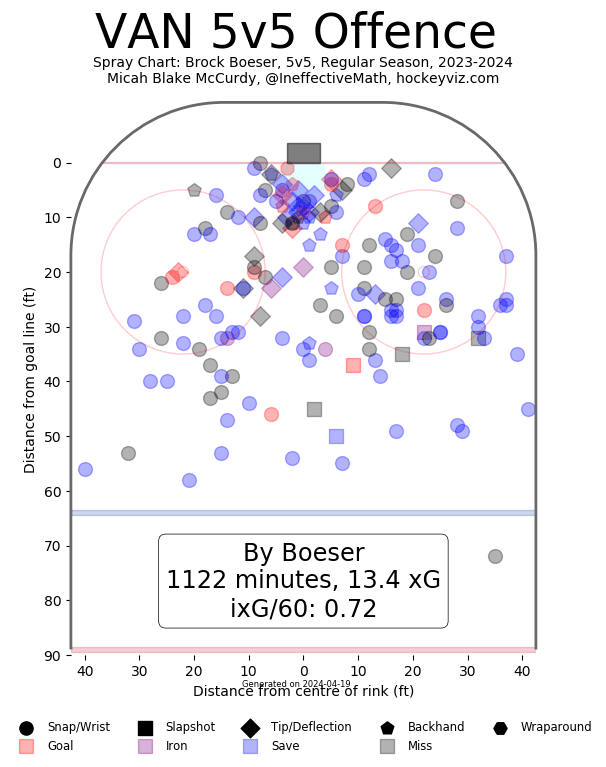
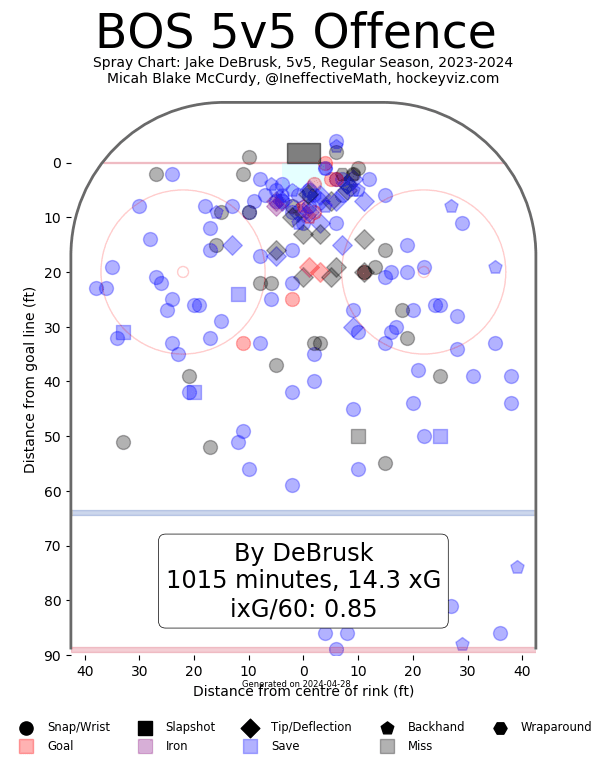
From HockeyViz.com
Shots from everywhere, of course, but a major conglomeration in and around the opposing net. A larger chunk of DeBrusk’s actual goals came from the net-front than Boeser’s, but then that’s probably to be expected with Boeser scoring more goals in general.
It’s safe to say that both players did their best and brightest work in 2023/24 while standing within a couple of feet of the other team’s goalie.
Which isn’t necessarily much of an issue moving forward at 5-on-5. If Boeser is skating on Miller’s wing, and DeBrusk is skating on Pettersson’s wing (or vice versa), the two can both continue to play a game with a net-front focus, and the Canucks will be better off for it as a whole.
The power play is another matter, however.
Here, the shot-charts show even more clearly how DeBrusk and Boeser specialized their special teams time in 2023/24:
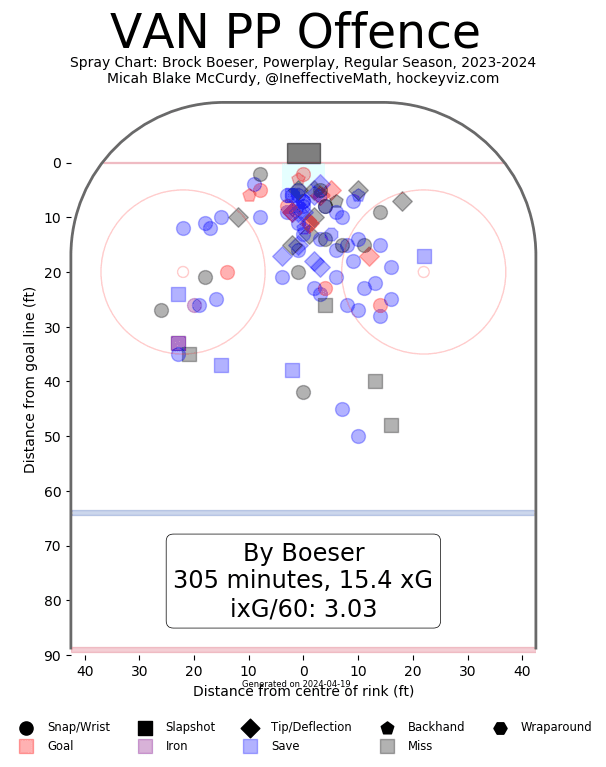
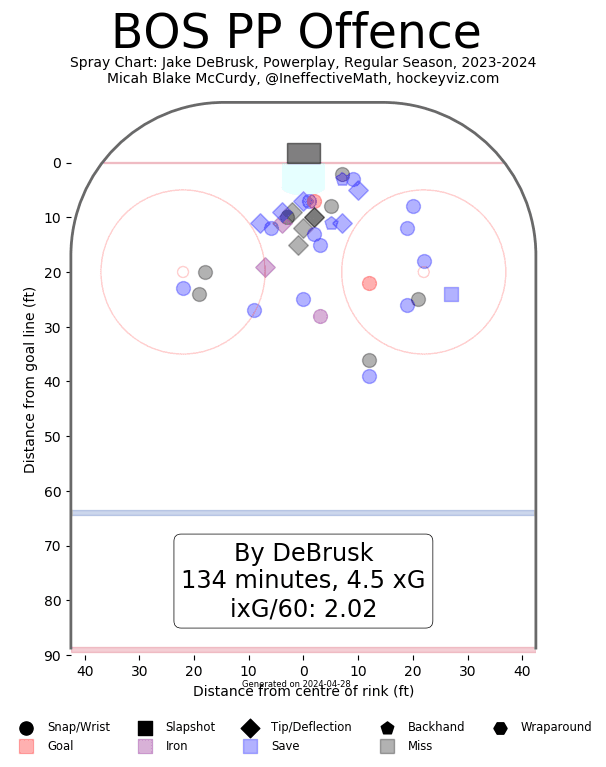
From HockeyViz.com
There’s a little bit of a volume issue on this comparison, in that Boeser played more than double the power play minutes that DeBrusk did last year.
But either way, both players attempted and recorded the bulk of their power play shots from either right in front of or slightly to the side of the net.
If both are going to be on the PP1 unit, one of them is probably going to have to move.
So, who would it be?
Presumably, the power play won’t be as stagnant as it has been in recent years, and the real truthful answer will be “both.” DeBrusk and Boeser will no doubt take turns operating as the PP1 net-front presence, and whoever is more successful will no doubt continue to get reps there.
One might suspect that DeBrusk has the upper-hand here, based on an occasional reputation as a ‘power forward’ that is honestly largely derived from the fact that his father was an NHL enforcer.
In reality, DeBrusk is the same height and listed as at least ten pounds lighter than Boeser. If we’re picking the one who would be toughest to move out from the slot, it’s probably Boeser.
Boeser and his 40 goals almost certainly have the better hands, too. Folks were outright surprised at how apt Boeser proved to be at deflections and redirected rebounds, especially as someone who arrived in the league as a de facto sniper.
So, the job seems like it’s Boeser’s to lose.
Then again, Boeser can do and has done a lot of different jobs well on the power play, too. He is a multifaceted scorer. Perhaps the thinking of head coach Rick Tocchet and Co. will be to plug DeBrusk into the net-front spot, where he’s comfortable, and use Boeser in another capacity that makes better use of his shot, like Bo Horvat’s old bumper position.
It is true enough that Boeser’s best asset is and always has been his shot, and that playing the net-front doesn’t always give him the opportunity to use it.
One other ‘solution’ – and we hesitate to even use that word for something that isn’t truly a problem – is to split Boeser and DeBrusk onto two different power play units. This would be a big departure from the Canucks’ tradition of loading up PP1, but perhaps it is time for that, anyway. The challenge then would be staffing out each unit with enough talent to ensure the puck is still getting to the net-front on a regular basis. It’s also worth noting here that the PP2 unit already has a fine net-front presence in Dakota Joshua.
Really, this article is mostly just an observation that the Canucks’ two top wingers possess a very similar shooting profile. And, again, that’s not necessarily a problem, just something that might have to be worked around a bit.
One could see DeBrusk’s addition as a great boon to Boeser, in that it could reduce his net-front duties and allow him to diversify his game more. Then again, one probably doesn’t want Boeser to stray too far from the style of play that landed him 40 goals last year.
As with any major roster shuffle, finding the right mix will be the challenge. But challenges aren’t always problems, and having more talent, even if that talent is a little redundant, is never a bad thing.
Sponsored by bet365
Breaking News
- The Statsies: A big game from Aatu Räty helps Canucks overcome Wild
- Wagner’s Weekly: Is Canucks’ Jim Rutherford pulling off a stealth tank?
- Canucks assign Jonathan Lekkerimäki to AHL Abbotsford
- The Stanchies: Youth carries Canucks in weekend win vs. Wild
- Instant Reaction: Räty scores a pair, Willander pots first NHL goal in Canucks’ 4-2 win over Wild
